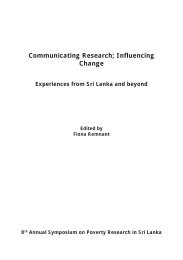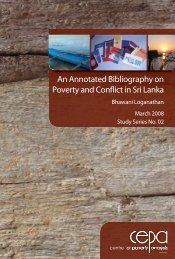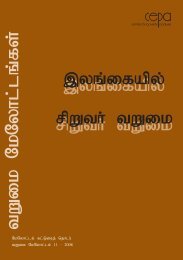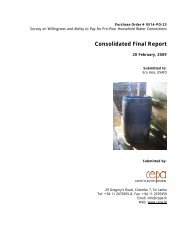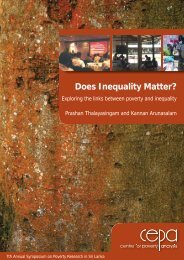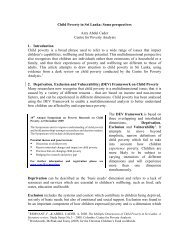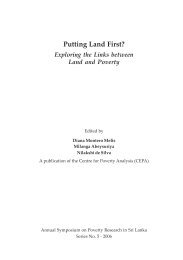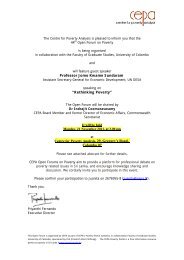Involuntary Displacement and Resettlement â Policy and ... - CEPA
Involuntary Displacement and Resettlement â Policy and ... - CEPA
Involuntary Displacement and Resettlement â Policy and ... - CEPA
- No tags were found...
Create successful ePaper yourself
Turn your PDF publications into a flip-book with our unique Google optimized e-Paper software.
Frequency distributions of pre <strong>and</strong> post-displacement(per capita totalhousehold incomes) are plotted in Panels 1 <strong>and</strong> 2 respectively. For thepre-displacement case the statistics which define the distribution includemean=136515, median=87033, SD=120578, skewness=1.418, SD ofskewness=0.277. For the post-displacement case the statistics aremean=38774, median=28948, SD=27434, skewness=1.621, <strong>and</strong> SD ofskewness = 0.277. Though income axes are common for both panels thefrequency axes are allowed to be different for clarity.Panel 1 of Figure 2 provides summary information such as frequencydistribution, mean, median, st<strong>and</strong>ard deviation (SD) etc. regardingpre-displacement income. Instead of family income which we have beenreporting <strong>and</strong> working with so far, in this diagram we report annual percapita income of the households, which was obtained by dividing annualhousehold income by the number of household members. According to thediagram, the pre-displacement per capita income of Sampur ranged fromRs.10,000 to Rs.395,000. We include statistics which summarise thisinformation. The mean, for example, is Rs.136,515, which is almostidentical to the per capital GDP figure for all Sri Lanka, Rs.136,223. We usethe latter to approximate the level of potential none-conflict income for theSampur people 14 . Does this mean that the economy of Sampur was notaffected by the conflict as postulated by the CID income curve in Section 2?The answer is an emphatic no. One can visually observe that the mean isnot a good representative of the pre-displacement income, or for thatmatter any distribution of income. This is because the distribution istruncated at the level of 0. This has resulted in a positively skewedfrequency distribution for income. Thus the median provides a bettersummary of income information than the mean. The median at a level ofRs.87,033 is much less than per capita GDP. In fact, the latter is 56% higherthan the median. This we believe is adequate evidence that the economy ofSampur since the start of conflict was performing below the potential level.This supports a key proposition forwarded by us in Section 2 that for peopledisplaced by conflict the loss of income sets in long before they aredisplaced.14Clearly, the Sri Lankan economy in its entirety is affected by conflict. Therefore, it is difficultto argue that its per capita GDP figure corresponds with the NR curve of Panel 2 of Figure 1.However, due to lack of an alternative we have sought to do that. The argument here is thatSri Lankan average would be more normal than that of Sampur, which is a village situated rightin the middle of the conflict zone.74



